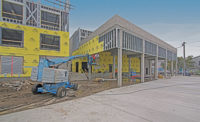The U.S. Army Corps of Engineers is completing the final third of $145 million in construction to armor earthen levees surrounding the New Orleans area to protect against erosion from the overtopping of storm surge. The project has been in the works since the aftermath of Hurricane Katrina.
To get the project to where it is today, the Corps has managed the complexities of 26 construction contracts while encountering delays from rising river levels and the need to raise more than half of the project’s levees to protective heights before armoring work could begin. The Corps also faced the challenges of COVID-19 and the limited availability of materials.
The project involves fortifying 77 miles of earthen levees in St. Charles, Jefferson, Orleans and Plaquemines parishes with a layer of fabric matting and Bermuda grass planted on top. The levees, which include 39 miles on the East Bank of the Mississippi River and 38 miles on the West Bank, extend along Lake Pontchartrain, parts of the Mississippi River and interior canals and waterways.
“While levee resilience is directly related to the quality of levee materials and their emplacement, armoring can augment existing levee materials to provide additional resilience,” said Sohelia Nazarain Holley, senior project manager with the U.S. Army Corps of Engineers in New Orleans.
The armoring work is part of the Corps’ $14.6-billion Hurricane and Storm Damage Risk Reduction System, a series of levees, floodwalls and infrastructure upgrades Congress funded after Hurricane Katrina to provide flood protection from a 100-year storm.
In May 2018, the Corps completed the last major piece of the risk-reduction system—the permanent canal closures and pumps on New Orleans’ outfall canals. But work like the levee armoring remains underway to add resiliency to the system.
As of July, 18 of the project’s 26 contracts had been completed, and eight were still under construction. This includes 26 of the 39 miles of armoring on the East Bank and 16 of the 38 miles on the West Bank.
Research-informed design
Armoring became a component of the Corps’ overall storm protection system based on findings by a task force of 150 nationally recognized experts the Corps assembled after Katrina to answer scientific and engineering questions about how the New Orleans levee system functioned during the storm.
The task force found that of the 50 major levee breaches that took place during Katrina, all but four were caused by a combination of overtopping and erosion. To address these issues, the Corps concluded that it would need to raise some levees and widen others, and that erosion protection in the form of armoring would be necessary in some areas.
“Armoring will increase resiliency against severe wave overtopping caused by hurricane storm surges greater than a 100-year storm event,” Holley says. “The structural features of armoring can be in the form of natural or artificial material that is placed on or around a levee or floodwall.”
“This [project] required us to tap into the municipal system and set up a delivery system, often miles long, that allows us to water several areas of grass daily without interruption.”
– Chris Rayer, Vice President, Shavers-Whittle Construction
Before construction could begin, the Corps undertook extensive research and development to figure out the most effective way to fortify the levees.
The Corps partnered with Colorado State University in 2010 to build a full-scale wave-overtopping simulator to test the erosion resistance of different armoring materials for up to 500-year storm resiliency. Meanwhile, the Louisiana State University AgCenter performed multiple tests on different grasses to determine how they would hold up against heavy mowing equipment.
Based on these two research programs, the Corps concluded it would use high-performance turf reinforcement mat as a base to cover the levees and then cover that matting with Bermuda grass grown from sod. Overall, the project has incorporated 4.5 million sq yd of matting and another 4.5 million sq yd of Bermuda sod.
Three contractors, 26 contracts
Because the project involved more than two dozen construction contracts, the Corps awarded work through a multiple-award task-order contract, or MATOC. The Corps relied on this method for several post-Katrina projects to streamline the number of contractors performing the work. As part of the process, contractors had to bid to be part of the MATOC; once the Corps selected its MATOC contractors, those contractors could then bid on each of the 26 individual projects, which involved installing the turf matting and planting sod over it.
The Corps selected three construction firms to divvy up the contracts, which totaled $145 million of the $250 million budgeted for construction. BIS Services LLC received $53 million in contracts, Circle Inc. received $66 million and Shavers-Whittle Construction received $26 million. The Corps awarded its first armoring contract in December 2014, a $5.9-million contract to Circle Inc. for a section of levees north of Destrehan. Construction began in 2015.
Unlike pre-Katrina floodwalls and levees, which incorporated many different designs and methods, the armoring program relied mainly on a core design. That meant the three contractors would be doing the same work but on different levee segments.
“This, along with the work being done in a MATOC, allowed for competitive bidding and efficiencies, which have reduced the overall program cost,” says Chris Rayer, vice president with Shavers-Whittle Construction.
During preconstruction, the Shavers-Whittle team members sought out ways to minimize the number of crew members it would need by using mechanical devices to do some of the work that would otherwise be done by hand on a similar but smaller project. This included methods to drive anchors and pins used to install the reinforcement matting. “The work that was to be done was going to be very labor intensive and repetitive; that was one of our first observations,” Rayer says.
Seeding storm protection
Supplying and installing materials presented a challenge for the project. Early on, the Corps realized it would not be feasible to acquire Bermuda sod and turf matting in advance of the contract awards. Doing so would require storage and the coordination of multiple contractors, and the timing and subsequent sequencing of this process presented the risk of delays and cost increases, according to the Corps. The solution was to have the contractors furnish the materials.
Most of the grass Shavers-Whittle has planted is grown in and around Foley, Ala., and trucked to the site daily, as needed. Weed and pest control for the newly planted grass is closely monitored, and treatments are applied as needed.
Caring for thousands of acres of sod was another consideration as contractors needed to water the sod for 60 consecutive days after planting it. To ensure healthy grass growth, Rayer says his team had to use potable water from a municipal source, as opposed to water from canals and other bodies of water that might introduce contaminants.
“This required us to tap into the municipal system and set up a delivery system, often miles long, that allows us to water several areas of grass daily without interruption,” Rayer says.
Contractors were able to rely on fire hydrants for an ample supply of water, although sometimes these hydrants were as far as three miles away.
Since growing the sod required more water than municipal systems could supply on demand, Rayer says his team set up temporary water storage tanks and refilled them overnight when the public’s water demand was lower. Using a meter, workers would tap into the municipal water supply and let water flow into the tanks as needed. Behind the tanks, crews set up a pump and a distribution line to deliver the water to sprinklers on the levees.
Levee lifts and a rising river
Some sections of the levees needed to be raised before any reinforcement work could take place. Of the 77 miles of levees in the project, 42 miles of levee required lifting.
With the exception of a few levee segments the Corps raised in St. Charles and Orleans parishes, most of these levee lifts were designed, constructed and paid for by local governing agencies such as levee districts. Some of these local agencies required passing a millage rate increase to fund the lifts.
Construction projects in close proximity of the Mississippi River face the additional challenge of having to limit construction when river levels rise. Whenever the river’s flood gauge reaches 11 ft, the Corps restricts below-ground construction work taking place within 1,500 ft of the river levee.
In 2019, river levels remained elevated for an unprecedented 292 days, which created significant challenges for the armoring project. “We typically expect a month or two of high river restrictions for a project of this scope,” Rayer says. “We were shut down from late January until mid-June of 2019, and again for a couple of months this year.”
Corps officials say they were able to expedite work to minimize the rising river’s impact on the project schedule.
The COVID-19 pandemic presented another unprecedented problem, and the project team had to contend with impacts to short-term travel, inspections and personnel. “We initially had difficulty filling some of the positions that we traditionally use temporary labor services for, but those worked themselves out over a few weeks,” Rayer said.
To address some of these issues, the Corps limited the number of team members participating in site visits and had members who attended those visits share their field notes and pictures with the rest of the team. Corps officials say there have been no long-term impacts from the crisis as of yet.
The project is on track for completion in 2021.











Post a comment to this article
Report Abusive Comment